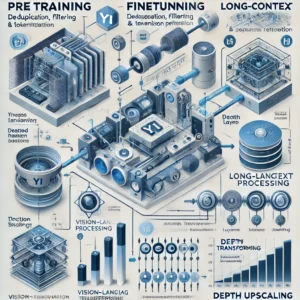Mathematics has always been a cornerstone of Artificial Intelligence (AI), influencing everything from algorithms to real-world applications. With the introduction of Qwen2.5-Math, the Qwen team has taken a monumental step forward in enhancing the mathematical reasoning capabilities of large language models (LLMs). Designed with a philosophy of self-improvement, Qwen2.5-Math not only matches the performance of previous industry benchmarks but also sets new standards in both English and Chinese mathematical problem-solving.
This blog explores the innovations, performance, and potential applications of Qwen2.5-Math.
Why Qwen2.5-Math Matters
AI’s ability to reason mathematically has been constrained by limitations in data quality, inference mechanisms, and contextual reasoning. Qwen2.5-Math addresses these challenges through:
- Self-Improvement Techniques: Leveraging the model’s own outputs for iterative refinement.
- Bilingual Excellence: Supporting both English and Chinese mathematical reasoning.
- Advanced Reasoning Frameworks: Introducing Chain-of-Thought (CoT) and Tool-Integrated Reasoning (TIR) capabilities.
The Building Blocks: Pretraining and Dataset Innovation
1. High-Quality Data Curation
The foundation of Qwen2.5-Math lies in its meticulously curated datasets. The Qwen Math Corpus v2 is an enriched collection of over 1 trillion tokens, featuring:
- Mathematical problems from web sources, books, and code repositories.
- Synthetic data generated by earlier Qwen models, ensuring diversity and quality.
- A balanced mix of English and Chinese content to address bilingual problem-solving.
2. Chain-of-Thought Reasoning
CoT reasoning enables step-by-step problem-solving, emulating how humans tackle complex mathematical challenges. The training dataset includes:
- 1 million annotated and synthesized problems across English and Chinese.
- Iterative refinement of solutions to ensure accuracy and reasoning depth.
3. Tool-Integrated Reasoning
Qwen2.5-Math incorporates Python-based symbolic computation to enhance accuracy in problems requiring algorithmic calculations, such as solving equations or matrix operations.
Post-Training: From Fine-Tuning to Mastery
1. Supervised Fine-Tuning (SFT)
Qwen2.5-Math utilizes a vast repository of mathematical problems and solutions, undergoing multiple iterations to refine accuracy. This process ensures:
- Precision in solving structured and algorithmic problems.
- Enhanced logical reasoning through CoT and TIR datasets.
2. Reinforcement Learning (RL)
By incorporating the Reward Model (RM):
- Models receive granular feedback on intermediate steps, improving reasoning pathways.
- Iterative training cycles refine both problem-solving capabilities and computational efficiency.
Performance: Redefining Benchmarks
The Qwen2.5-Math series has undergone rigorous evaluation across 10 mathematical datasets, spanning grade-school problems to Olympiad-level challenges. Key highlights include:
- English Benchmarks:
- Achieved 66.8 on the MATH dataset (up 5.3 points from Qwen2-Math).
- Outperformed GPT-4o and other leading models on GSM8K and STEM tasks.
- Chinese Benchmarks:
- Set new records on GaoKao and CMATH datasets.
- Demonstrated superior bilingual reasoning, surpassing models like Gemini Math-Specialized.
Small Models, Big Results
Even the smallest Qwen2.5-Math-1.5B model outperforms most 70B models, showcasing the efficiency of its training and architectural enhancements.
Innovation in Action: Tool-Integrated Reasoning
One of the standout features of Qwen2.5-Math is its TIR capability. By integrating external tools like Python interpreters:
- Models can perform precise calculations, minimizing computational errors.
- TIR enhances performance on datasets requiring symbolic or algorithmic reasoning, such as AIME and AMC.
Real-World Applications
The advanced capabilities of Qwen2.5-Math have far-reaching implications:
- Education: Assisting students with complex problem-solving in mathematics and STEM fields.
- Enterprise AI: Enabling automation in industries requiring mathematical precision, such as finance and engineering.
- Research and Development: Supporting breakthroughs in science and technology by solving challenging mathematical problems.
Looking Ahead
Qwen2.5-Math is not just a mathematical model; it’s a vision for the future of AI. By combining scalability, accuracy, and bilingual capabilities, it paves the way for more robust and accessible AI systems. The ongoing development of Qwen models signifies a commitment to pushing the boundaries of AI reasoning and problem-solving.
Explore the Qwen2.5-Math models on Hugging Face or GitHub.






Be First to Comment